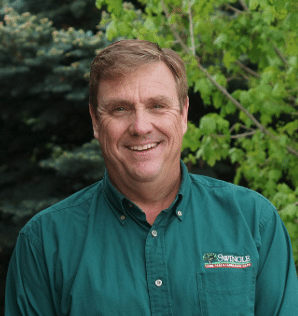
We turn to our resident expert, Tony Hahn, for an informative fall landscape Q&A perfect for homeowners across the Front Range.
 Why do you prune trees in the dormant season?
Why do you prune trees in the dormant season?Some trees are more susceptible to disease than others. If they become infected and the disease is not pruned out, it can and will spread more deeply into the tree. Pruning when temperatures are colder and humidity levels are lower minimizes the risk of spreading active infections. Dormant pruning typically is scheduled between mid-November and early April.
Root growth and development are the most important reasons to prepare your lawn prior to winter’s onset. Without a strong, deep root system, your lawn becomes stressed and is less likely to withstand extreme winter weather.
Front range communities can experience long durations of dry weather between snowstorms.
Roots are primarily made up of proteins and carbohydrates – derived from nitrogen-based fertilizers. Other components of root function are potassium and phosphorous – included in “winterizer” fertilizers. Many years of experience in the lawn care industry has reinforced that without good root growth in the fall, your chances of having a beautifully thick lawn come the spring are greatly reduced.
Clay soils, which encompass much of the front range, are notoriously compact. Heavy, wet, clay soils do not contain much oxygen, which is necessary for respiration and root growth. Soils with lots of organic matter have naturally occurring pore spaces, allowing plenty of oxygen into the soil. Since clay soils compact easily, it is critical to alleviate the compaction for better air, water, and fertilizer penetration to the roots.
Aeration is suggested at least twice a year. Overseeding, which often accompanies a fall aeration, is also recommended when soil temperatures are still high enough to allow for germination. Seeding also helps break up monocultures in lawns, which can increase disease resistance as well. If you want a healthy and beautiful lawn come the spring, you have to do some work in the fall.
Tony Hahn is one of Swingle’s Landscape Care Consultants and a Certified Arborist. He’s known as “The Voice of Swingle”, as seen on our local Colorado TV stations.